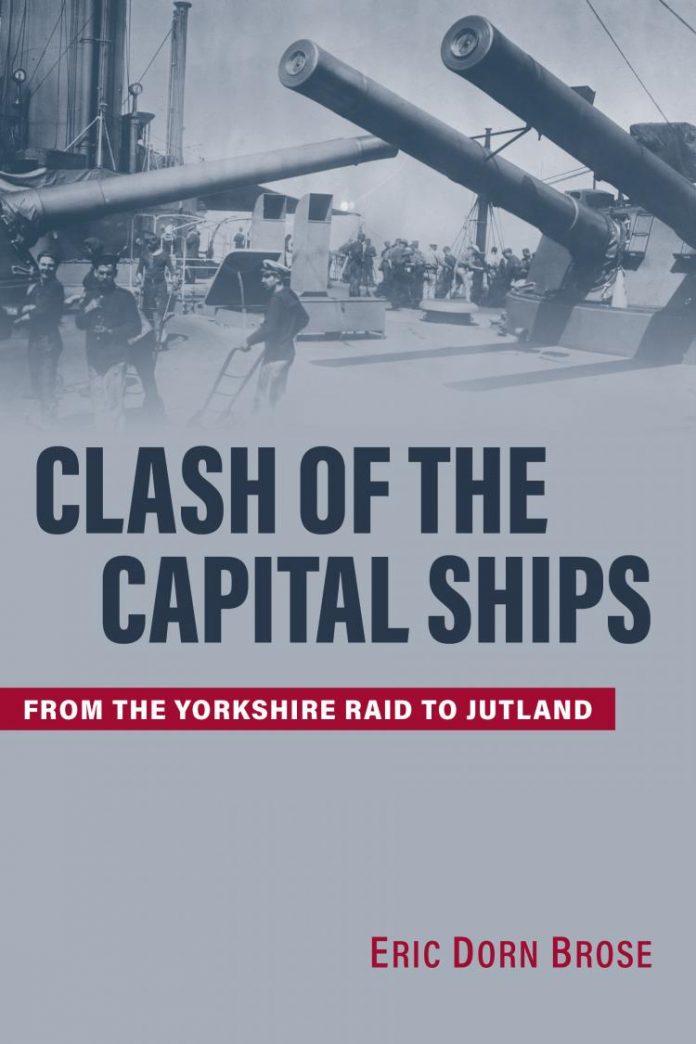
Clash of the Capital Ships; from the Yorkshire Raids to Jutland. By Eric Dorn Bose. Naval Institute Press, Annapolis, Maryland, 2021.
Reviewed by Tim Coyle
‘But why should any historian write another book about Great War naval encounters in the North Sea culminating with Jutland?’. So questions the author of ‘Clash of the Capital Ships’, Eric Dorn Bose, pointing to a 1992 annotated bibliography listing 528 Jutland-related titles and admitting this does not include the further titles added since then culminating in the 2016 centenary of the battle.
Bose is an academic historian, granted special emeritus status at Drexel University, Philadelphia, on his retirement in 2015. As such, he justifies this work to address ‘the differing opinions among the latest, high-quality monographs warrant(ing) further discussion and synthesis. The argument for a revisitation strengthens given the wealth of valuable primary material that has surfaced in recent decades’.
This reviewer has Jutland-related works by Marder, Goldrick, Massie, Gordon and Jellicoe (Nicholas – grandson) in his library. Marder, titan of RN history in the dreadnought era, devoted volume three of his five-volume 1960s masterwork ‘From the Dreadnought to Scapa Flow’ to ‘Jutland and After May 1916 to December 1916’ replete with 16 track charts. The other authors, all respected in their fields, added more recent scholarship, culminating in Nicholas Jellicoe’s ‘Jutland, the Unfinished Battle’, a first-class work marking the battle’s centenary. These latter works may be contrasted to the ‘first generation’ highly controversial ‘The Truth About Jutland’ by Rear Admiral Harper in 1927 and ‘The Jutland Scandal’ by Admiral Sir Reginald Bacon in 1933 – re-published as a combined volume in 2015.
Bose has risen to this self-imposed challenge by offering a most readable narrative of the battle. He entered a crowded field with multitudes of Jutland enthusiasts – from academics to amateur admirals - ever-ready to scour new treatments of this fascinating engagement. One of the book’s strengths is Bose’s profiles and commentaries on the commanders on both sides. He plumbs a vast range of sources to profile the four admirals, Jellicoe and Beattie, Scheer and Hipper, their senior subordinates and the limitations under which they operated: the strategic, the operational and the technical. Kaiser Wilhelm’s reticence in risking the High Seas Fleet and the Admiralty’s operational oversight inhibiting Jellicoe’s initiative which was characteristically stunted by fears of submarines and mines. The vain-glorious Beattie was a weak link on the Day. These, when added to the scandalous British shell inadequacies and dangerous shell-handling practices in the battle-cruisers, robbed the RN of its second Trafalgar.
Despite including the pre-Jutland German raids on the British coastal towns on 03 November and 16 December 1914, no track charts are provided; nine track charts accompany the Jutland battle. Although these charts are clearly rendered, some might find this less than adequate and I had recourse to my copy of ‘The Great War at Sea; a Naval Atlas 1914-1919’. However, Jutland adherents have ample on-line or hard copy resources to track the fleets’ movements (I find it difficult to restrain myself not reaching for track charts when reading about naval battles). The copy of Clash of the Capital Ships provided for review was a pre-publication ebook with no images – presumably these will feature in the published copies.
It will be up to individual readers to decide for themselves whether Bose has succeeded in his aim of providing a new contemporary assessment of the Battle. However, Clash of the Capital Ships will likely be a candidate for the true Jutland enthusiast to acquire and digest for their library, perhaps as Jutland book 529. Those for whom Jutland is a new experience will find Clash of the Capital Ships an absorbing commentary.



